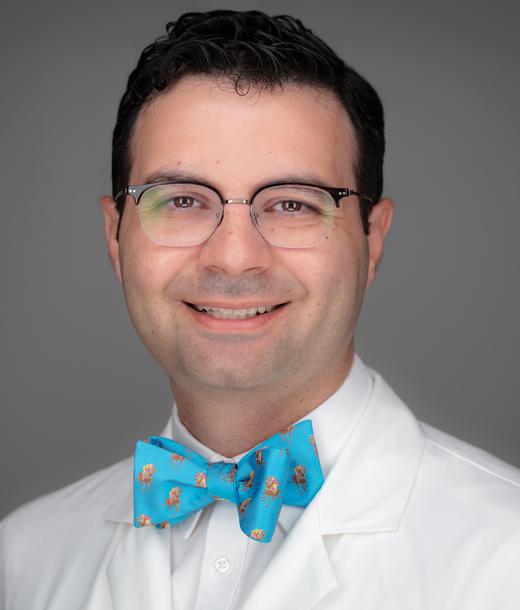Updated Data Show Efficacy of Tafasitamab/Lenalidomide in R/R DLBCL
In the first article of a 2-part series, Hayder Saeed, MD, discusses the 5-year follow up data from the L-MIND study, which shows the continuing efficacy of tafasitamab and lenalidomide for patients with relapsed/refractory diffuse large B-cell lymphoma.
CASE
- A 67-year-old man presented with fatigue, back pain, and lymphadenopathy.
- Medical history: Hypertension, well controlled with medication
- Physical exam: Left posterior cervical, 1.5-cm node; right anterior cervical node, 2.5-cm; left supraclavicular node, 2.0-cm.
- PET-CT scan: multiple enlarged mesenteric and retroperitoneal nodes, largest measuring 5.3 x 3.1 cm
- Bone marrow biopsy was negative.
- Biopsy confirmed diffuse large B-cell lymphoma (DLBCL), non-germinal center B-cell, double expressor lymphoma.
- Immunohistochemistry positive for: CD20, BCL-6, BCL-2 (50% of cells), MYC (> 40% of cells), Ki67 85%, MUM1. Negative for CD10.
- Normal CBC
- Lactate dehydrogenase elevated
- Stage: III
- International Prognostic Index: high-intermediate risk.
- ECOG performance status: 1; non-germinal center
- Fluorescence in situ hybridization: negative for translocations involving MYC, BCL2, BCL6
- Six cycles of polatuzumab vedotin-piiq (Polivy) plus rituximab (Rituxan), cyclophosphamide, doxorubicin, and prednisone (R-CHP) was initiated, and back pain was resolved during treatment.
- Post-treatment PET scan demonstrated a complete response with a Deauville score of 2 the patient was observed.
- Eight months after completion of therapy, he complained of fever, night sweats, and back pain again.
- A palpable lymph node in the left groin was discovered on physical examination.
- PET and CT scan: new left inguinal lymph node, increase in size of residual node, as well as multiple metabolically active lesions in lymph nodes of the retroperitoneum, abdomen, and pelvis.
- Biopsy confirmed DLBCL, but next-generation sequencing (NGS) was not performed.
- The patient was referred to nearest transplant and cellular therapy center for evaluation, but ultimately opted not to pursue chimeric antigen receptor (CAR) T-cell therapy.
- The patient prefers to stay with current care team but is still seeking further treatment. However, he wants to receive outpatient treatment due to lack of support system.
Targeted Oncology: What led to the approval of tafasitamab (Monjuvi) and lenalidomide (Revlimid) for patients with relapsed/refractory DLBCL?
HAYDER SAEED, MD: Tafasitamab plus lenalidomide was approved based on the L-MIND study [NCT02399085].1 This study enrolled patients with relapsed/refractory DLBCL who had 1 to 3 prior lines of treatment and were not eligible for stem cell transplant. Primary refractory patients were excluded initially, and those [were defined as patients] who were refractory to frontline therapy within 3 to 6 months. Patients [on the trial] first received first 12 mg/kg of tafasitamab weekly for the first 3 cycles and then it was done every other week subsequently, until disease progression. They all received lenalidomide for 1 year and lenalidomide was encouraged to stay around 25 mg per day.

We all have difficulty with maintaining lenalidomide at 25 mg per day, [because of the] toxicity associated with it. It’s OK if some patients will have to drop to 20 mg or if you have to drop to 15 mg, but this is one of those situations where you try to maintain your dose at least at 20 mg to 15 mg, because data have shown that the lower dose of lenalidomide has less efficacy for patients with DLBCL.1
Were there any efficacy changes at the 5-year follow-up of these data?
Between the initial release [of the data] in 2018 and the subsequent [5 year follow-up] release, there was really no difference in outcome.2 The overall response rate [ORR] at 5 years was 57.5% [95% CI, 45.9%-68.5%], the complete response [CR] rate was at 41.3% [95% CI, 30.4%-52.8%], and the rate of partial responses is at 16.3% [95% CI, 8.9%-26.2%]. The duration of response was not reached in the updated 5-year data. For the patients who responded, their median progression-free survival [PFS] was 11.6 months [95% CI, 5.7-45.7] and stayed stable.
If you look at the difference...between the patients who received this regimen in the second line vs third line and fourth line, there was a significant difference in their outcomes. [For example], those patients who received [tafasitamab plus lenalidomide] in the second line will have a median PFS of 23.5 months [95% CI, 7.4–not reached (NR)] compared with 7.6 months [95% CI, 2.7-45.5] in those who received the treatment in the third- or fourth-line [of therapy].2
How do you know which patients who are refractory to frontline therapy will have a good outcome with this combination treatment?
This is what the [trial was powered for], to…find the right patients that would respond to this combination regimen. The good thing is that...within the first 3 months of treatment you will probably know which one your patient...will respond to this treatment and have a pretty good chance of having a long remission vs those who will drop off and will move on to other lines of treatment.
So that's why it's not a regimen that will perfectly fit every patient you have with relapsed/refractory DLBCL, but I think it will have a role in a pretty good number of patients. The right patient [could include those] with less bulky disease in whom you discover the disease earlier; maybe they are not candidates for CAR T-cell therapy for one reason or the other, or they're an elderly patient who...doesn't want to disrupt their life. Patients who are not primary refractory but might benefit from this treatment if they do respond the next 3 to 6 months [after treatment initiation].
References:
1. Salles G, Duell J, González Barca E, et al. Tafasitamab plus lenalidomide in relapsed or refractory diffuse large B-cell lymphoma (L-MIND): a multicentre, prospective, single-arm, phase 2 study. Lancet Oncol. 2020;21(7):978-988. doi:10.1016/S1470-2045(20)30225-4
2. Duell J, Abrisqueta P, Andre M, et al. Tafasitamab for patients with relapsed or refractory diffuse large B-cell lymphoma: final 5-year efficacy and safety in the phase II L-MIND study. Haematologica. 2023. doi:10.3324/haematol.2023.283480